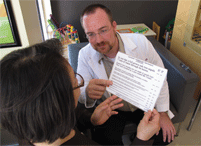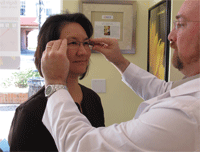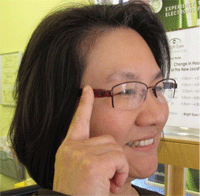Presbyopia, although normal and inevitable, is the first unmistakable, irreversible sign for many patients that they are getting older. So, when working with presbyopic patients, it’s even more important than usual for us to consider the psychological and emotional implications of our recommendations.

Presbyopia happens to everyone eventually, but that doesn't mean it's routine for the patient in your chair. To patients, presbyopia is the first unmistakable sign of age.
Acknowledging these emotions proactively is important, but it must be done in the right way. Years ago, as an optician, I tried to be light-hearted and positive about presbyopia by saying something like, “This happens to everyone eventually. Congratulations, you’ve made it. You’ve earned these bifocals!”
Unfortunately, this never, ever, ever worked.
To our patients, presbyopia is a very big deal. Not only does it have emotional implications for most people, but also it greatly increases their complexity of choices in vision care. Our aging population increasingly demands excellent near vision for viewing computers and other digital devices—and at the same time, they have higher expectations than ever for crisp distance, intermediate and near vision, as well as spectacle independence.
For optometrists, presbyopia management presents an opportunity to increase the bottom line, but it also can consume significant chair time and result in frustrated patients. So, here are some ideas about what to do with patients who are “new” to presbyopia.
Presbyopes by the Numbers
As we all know, presbyopia has a high prevalence. Although age 40 commonly is cited as the onset of presbyopia for epidemiology estimates, the highest incidence (first complaints) actually occurs between age 42 and 44.1
One study found that more than one billion people in the world were presbyopic as of 2005, and that may reach almost 2 billion by 2050.2 If presbyopia is defined as a visual condition of everyone over the age of 45, then an estimated 122 million Americans had presbyopia in 2010, according to U.S. Census Bureau figures.3
And, as more baby boomers begin to have trouble at near, this number is only going to go up.
‘Presbyopia? What’s That?’
Generally speaking, patients don’t quite understand what presbyopia is. They may have some notion that vision “changes” as they get older; but for most of their life, they’ve been unaware that accommodation existed and have thought of vision purely in terms of distance acuity.
Additionally, the term “presbyopia” is confusing to patients. They have told me that because it contains the prefix “pre-,” patients may misinterpret it to be the beginning of a medical condition and become concerned.
A 2011 survey of American consumers, conducted on behalf of Transitions Optical, reinforced a great need to educate patients on what presbyopia is, how it affects vision and which treatment options are best. More than eight in 10 Americans (83%) say they are not familiar with presbyopia—and more than six in 10 (63%) mistakenly believe that it can lead to blindness.4 (To that end, the American Society of Cataract and Refractive Surgery hired a product-branding agency to come up with a better, clearer term for presbyopia.5 The result: “age-related focus dysfunction.” Perhaps not surprisingly, “ARFD” hasn’t really caught on with either the eye care community or the public.)

The challenge with presbyopes is to ascertain their level of understanding and stage of acceptance—and then present options that they find tolerable, meet their needs, and are also profitable for our practice.
Even more concerning is that, independent of what it is called, patients do not understand how to deal with presbyopia appropriately. According to the Transitions survey, even if people experience trouble seeing up close, one in three said that they would not schedule an appointment with their eye doctor.4 And fewer than four in 10 (38%) said that they would purchase prescription eyewear from their eye doctor. Instead, nearly one in five said they would do eye exercises (19%) or take vitamins (18%) to try to improve their eyesight.4
Clearly, we have a lot work to do in educating our patients about presbyopia and the options available to them. As with any treatment decision, patient selection is important. Because presbyopia management always involves some level of give and take, we cannot simply hand patients a prescription. We must discern what their beliefs and expectations are. (See “Grief Over the Loss of Good Vision,” below.)
Patients do not realize that an optometrist’s skill is largely in the psychology of vision. They often think that we gather data about their eyes and simply give them the corresponding prescription. The challenge with presbyopes is to ascertain their stage and understanding of presbyopia, and then present options that they find tolerable, meet their needs, and are also profitable for our practice.
• Denial. The patient who does indeed
have trouble at near, but refuses to admit it. This may be minor or
infrequent enough that it does not interfere with work, hobbies or home
life. Ideally, these patients are best left as is. Because presbyopia
options involve some level of trade-off, it is not helpful to create a
problem for them, regardless how small.
• Annoyance. The patient who acknowledges he has trouble, but just doesn’t care enough to make changes. • Bargaining. The patient who believes
that, with enough time, money and effort, he can have the vision that he
had 20 years ago. While these patients are very motivated, they may
also have unrealistic expectations. • Acceptance. The patient who realizes
that vision isn’t what it used to be, but with the right choices, she
can still work and play as she used to d
Grief Over the Loss of Good Vision
Presbyopia progresses slowly over many
years. And, because it truly is a loss of the visual freedom of seeing
comfortably up close, I find it useful to consider new presbyopes’
progress as “stages of presbyopia,” which I have adopted from
Kübler-Ross’ stages of grief:
Options for New Presbyopes
While
earlier generations of presbyopes may have simply learned to deal with
lined bifocals or progressives as a necessary evil, today’s baby boomers
have much higher expectations. Fortunately, there are now many options
for managing presbyopia.
• Do nothing. If the patient is either in denial or mildly annoyed, often the best course of action is to change nothing. If progressive lenses or contacts are prescribed before the patient is mentally prepared, they may go unused—or even worse, may be resented. This is especially true for myopes who can simply remove their glasses to see very small text. This uncorrected view often looks and feels more natural than multifocal correction, even if the measured near vision acuity is better.
• Glasses. The use of spectacles in some form is so ubiquitous for presbyopes that, like gray hair, glasses are a classic element of the mental picture of an “old person.”
The fact is, for most presbyopes, they work. While over-the-counter readers are mass-produced with cheap materials, they do allow patients who don’t require distance correction to read a menu and use a phone. This may be adequate for patients who are merely annoyed or simply accepting of presbyopia. Even so, be sure to educate them about the benefits of customized single-vision near prescriptions, quality lens materials and coatings, and optical-quality frames.
One key part of the process of accepting presbyopia is the patient’s understanding that a single pair of glasses simply will not meet all of his needs. For patients with a distance prescription, the selection of multiple single-vision prescriptions, lined bifocal or trifocal prescriptions, or progressive-addition lenses (PALs) for everyday use is based on a combination of lifestyle and desire.
With new digitally-surfaced PALs, most patients rapidly adapt to them; but patients whose primary concern is to have the very widest width of reading area may be better suited to lined bifocals. Traditional PALs are not designed to optimize intermediate vision, so office workers should be educated on the benefits of near variable focus or “computer PALs.” And don’t forget about pre-presbyopic patients who are at risk for computer vision syndrome—they can benefit from some of these lenses, too.
Additionally, there are new developments in multifocal lens technology. The electronic emPower! eyewear (PixelOptics) makes use of LCD lenses to provide additional plus power for near viewing. The Superfocus lens is manually adjusted by a slider on the bridge of the frame. These advanced options may appeal to high-tech, “bargaining” patients who are reluctant to give in to presbyopia; they also set your practice apart, and provide unique word-of-mouth advertising.
• Contact lenses. As with glasses, there are now many contact lens options for presbyopes: soft and RGP, simultaneous distance and near designs, and even multifocal toric contact lenses.
Historically, many presbyopic contact lens wearers have been prescribed monovision. While this is still useful, our patients only have two eyes and often need three areas of vision correction: distance, intermediate and near. Use of multifocal contacts can provide greater range of clear vision while preserving binocular vision.
Finally, spectacles to wear over the contacts, either to improve distance or near vision, are always an option when needed.
• Surgical procedures. Just as optometric practices benefit from the broad range of presbyopia options, so do ophthalmology practices and surgeons now offer a wider array of procedures to meet their needs. For patients who have a successful history of monovision contact lens wear, monovision LASIK may be an option. Multifocal intraocular lenses are used with success for patients requiring cataract surgery and are increasingly used for patients without cataracts (clear lens exchange).
Marketing To Presbyopes
Marketing to presbyopes can be difficult. Because patients take presbyopia personally, adhering to the axiom “under-promise, over-deliver” is important.
Low presbyopes, who have generally had great distance vision—and been proud of it—will find everything blurry far away. Myopes, who could see great up close without correction, will not understand why they can’t see great up close. High astigmatism complicates everything. And, complaints of dryness or discomfort with contacts are more common.


High-tech options, such as Superfocus lenses (right) or emPower! eyewear (left) may appeal to patients who are reluctant to give in to presbyopia.
Despite all of this, it is possible to effectively communicate that there are presbyopia treatment options and that you are an expert in this area.
• Exam room education. As with all optometric products and services, the conversation that occurs in the exam room is the most effective. During this time, we discuss specific recommendations and the benefits of each prescription. Although presbyopia is a universal condition, it doesn’t feel that way to the patient. Try to convey how the patient’s situation is special or unique so that he or she is engaged in the process, rather than just making an accession to “getting old.”
• Internal marketing. There’s no reason to wait until patients enter the exam room. The medical history questionnaire presents an excellent opportunity to ask about near vision difficulties and options. Pamphlets, posters, waiting room video screens and on-hold messages can all be used to highlight specific products that you frequently recommend. Many companies produce direct-to-consumer marketing materials that can also be used (but review them carefully to ensure they do not “over promise” and are consistent with your overall marketing strategy).
• External marketing. To reach new presbyopic patients, feature your new products and services on your website or blog. Take advantage of media coverage of new developments in technology by linking to the story and explaining that you offer the product.
For example, a significant amount of news coverage has featured the new emPower! lenses. Add links to the coverage on your website, Facebook page or Twitter feed, and put your own twist on it. This “buzz” can be used to position your office as high tech, and may lead to media opportunities for you as the vision expert. These segments can then be saved and used for future campaigns.
• Word of mouth. Satisfied patients produce the best marketing. When a patient is overjoyed with the vision in their multifocal contact lenses or IOLs, their friends and family take notice. You can promote this by encouraging a patient to leave a review of their experience online for other patients to see.
Presbyopia may not be the most exciting condition for us to deal with, but there are more methods for managing it now than at any other time in history. By taking the time and effort to consider all of the options, optometrists can improve the quality of life of our presbyopic patients by making them feel like active participants in this multifaceted high-tech process—and not so old, after all!
Dr. Bonilla-Warford is in private practice in Tampa, Fla., and specializes in vision therapy and orthokeratology. He is a frequent lecturer and writer about social media in eye care. Find ways to connect at
http://about.me/NateBW.
1. Kleinstein RN. Epidemiology of presbyopia. In: Stark L, Obrecht G, eds. Presbyopia: Recent Research and Reviews from the Third International Symposium. New York: Professional Press Books; 1987: 12-8.
2. Holden BA, Fricke TR, Ho SM, et al. Global vision impairment due to uncorrected presbyopia. Arch Ophthalmol. 2008 Dec;126(12):1731-9.
3. U.S. Department of Commerce, Bureau of the Census. Intercensal Estimates of the Resident Population by Sex and Age for the United States: April 1, 2000 to July 1, 2010. Available at: www.census.gov/popest/data/intercensal/national/nat2010.html (accessed January 2012).
4. Wakefield survey on behalf of Transitions Optical, Inc., among a representative sample of more than 2,200 Americans ages 18+. April 2011. Available at: http://pro.transitions.com/NewsEvents/Press%20Releases/nr_Multicultural%20Research.pdf (accessed January 2012).
5. American Society of Cataract and Refractive Surgery. Age-Related Focus Dysfunction: A term to aid patient education about presbyopia. Press release, August 12, 2010; Fairfax, Va. Available at: www.ascrs.org/press_releases/loader.cfm?csModule=security/getfile&pageid=19064 (accessed January 2012).

